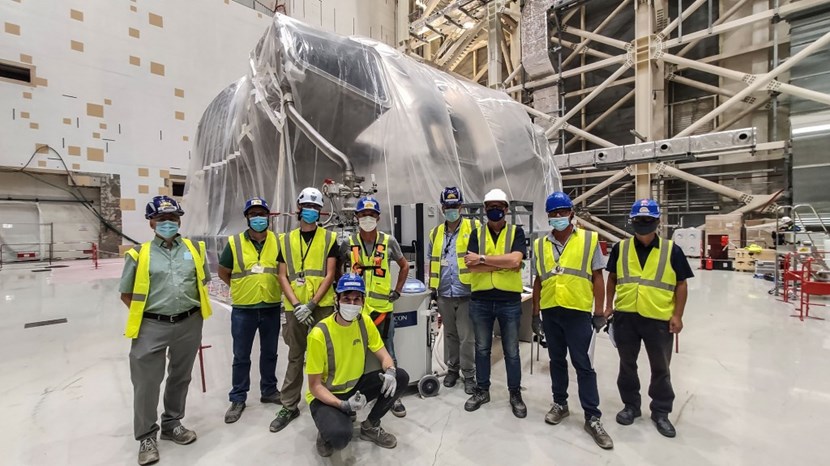The first ITER vacuum vessel sector has passed a helium leak test on site with flying colours.

Molecules of any nature leaking into the plasma chamber could contaminate the plasma and potentially cause the fusion reaction to stop. Vacuum vessel sector #6 passed its helium leak test with flying colours on 4 September 2020, confirmed to be leak tight to two orders of magnitude better than acceptance criteria.
Back in March 2020, as experts from the Korean Domestic Agency and Hyundai Heavy Industries were carrying out final
quality control evaluations, vacuum vessel sector #6 was subjected to a series of factory acceptance tests, which it passed successfully.
The most critical of these—the helium leak test—is a way to ensure at the end of the manufacturing process that no leaks in the many welds in a vacuum vessel sector have been overlooked or allowed to pass, and it demonstrates the absolute leak tightness of the component.
In a typical year, an observer/quality control inspector from the ITER Organization as well as an inspector from the Agreed Notified Body (authorized by the French Nuclear Regulator ASN to assess the conformity of components in the pressure equipment category) would have been present for the tests in Korea. But because these visits were rendered impossible by COVID-19 travel restrictions—and not wanting to delay the shipment of the component—it was agreed that acceptance activities would be split between Hyundai Heavy Industries and the ITER Organization ,with Hyundai responsible for demonstrating the safety leak rate requirement at the company's premises and the ITER Organization responsible for the more stringent operational leak rate requirement as part of acceptance tests on site.
On 2 September, approximately one month after the component's
arrival, the ITER vacuum team enclosed the 440-tonne vacuum vessel sector in a plastic bag filled with 100 cubic metres of helium gas—or the equivalent of 10,000 party balloons—while pumping the sector's interspace to create a vacuum.
As helium—the second lightest element—can pass through any crack in the vessel boundaries, no matter how small, any presence of helium in the interspace would be detected by the leak detection system based on ultra-sensitive mass spectrometry.
The result was completely successful, with no leaks above the limit of detection found. Vacuum vessel sector #6 is confirmed to leak tight to 10-10 Pam³s-1, which is two orders of magnitude tighter than the acceptance criteria. The test was carried out with the Agreed Notified Body inspector as witness.
"This is a major achievement," says Liam Worth of the Vacuum Design and Delivery Section. "Normally to reach this leak test sensitivity one would expect to bake the vacuum vessel sector to condition the interspace for the test. However for the sector #6 baking was not required as the stringent cleanliness requirements of the shield blocks installed in the interspace have been respected—this is good news as it is likely that other sectors will not require baking either, thus saving time and money."
The test protocol for vacuum vessel leak testing, as well as the equipment, was developed by the ITER vacuum team. (See more
here).
"The idea of performing the leak test in this way was first proposed some 14 years ago and we have been refining the procedure through test qualifications since," says Robert Pearce, Vacuum and Design and Installation Section Leader. "We are all looking forward to repeat test successes as the other sectors are manufactured and delivered."


